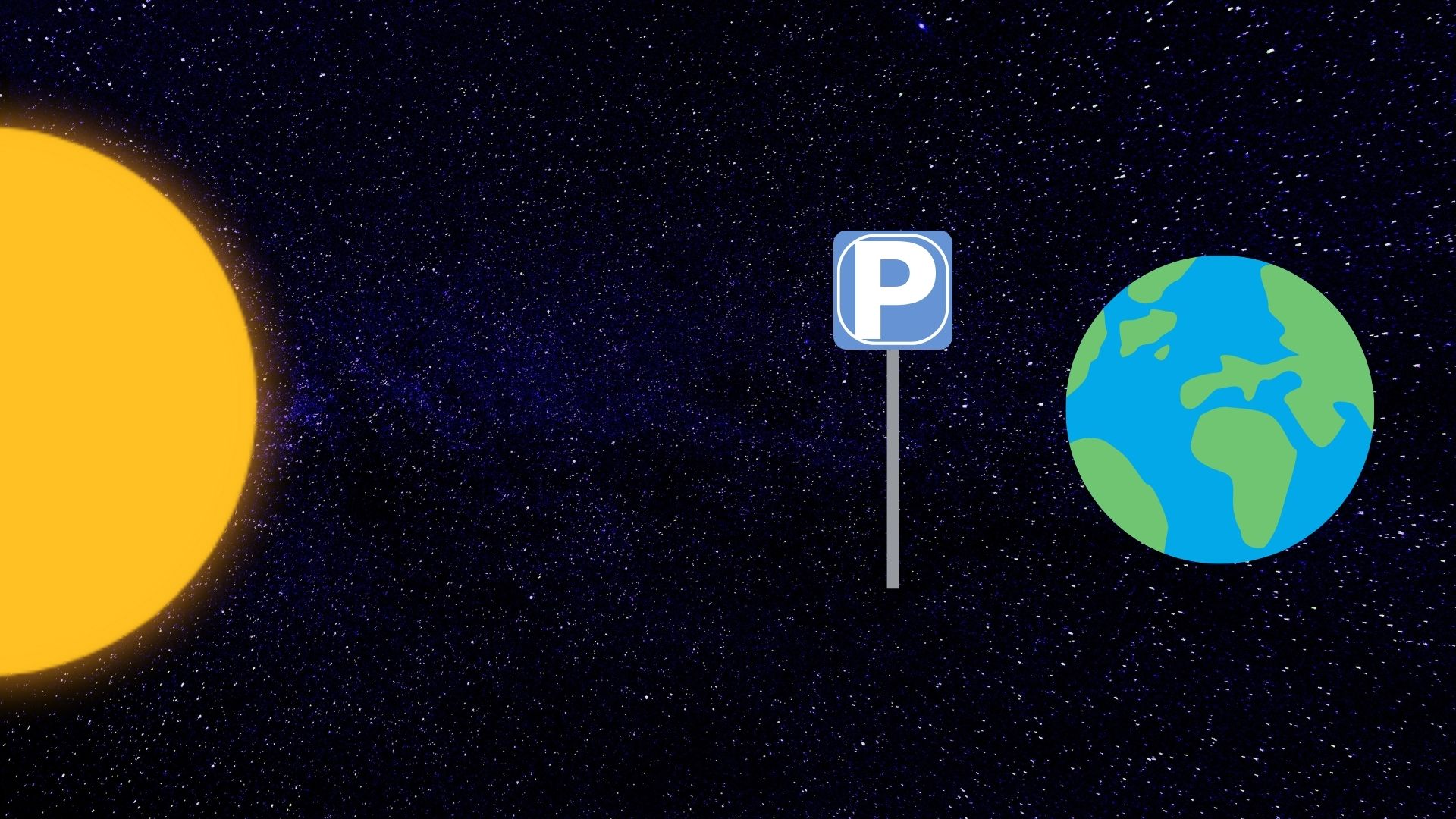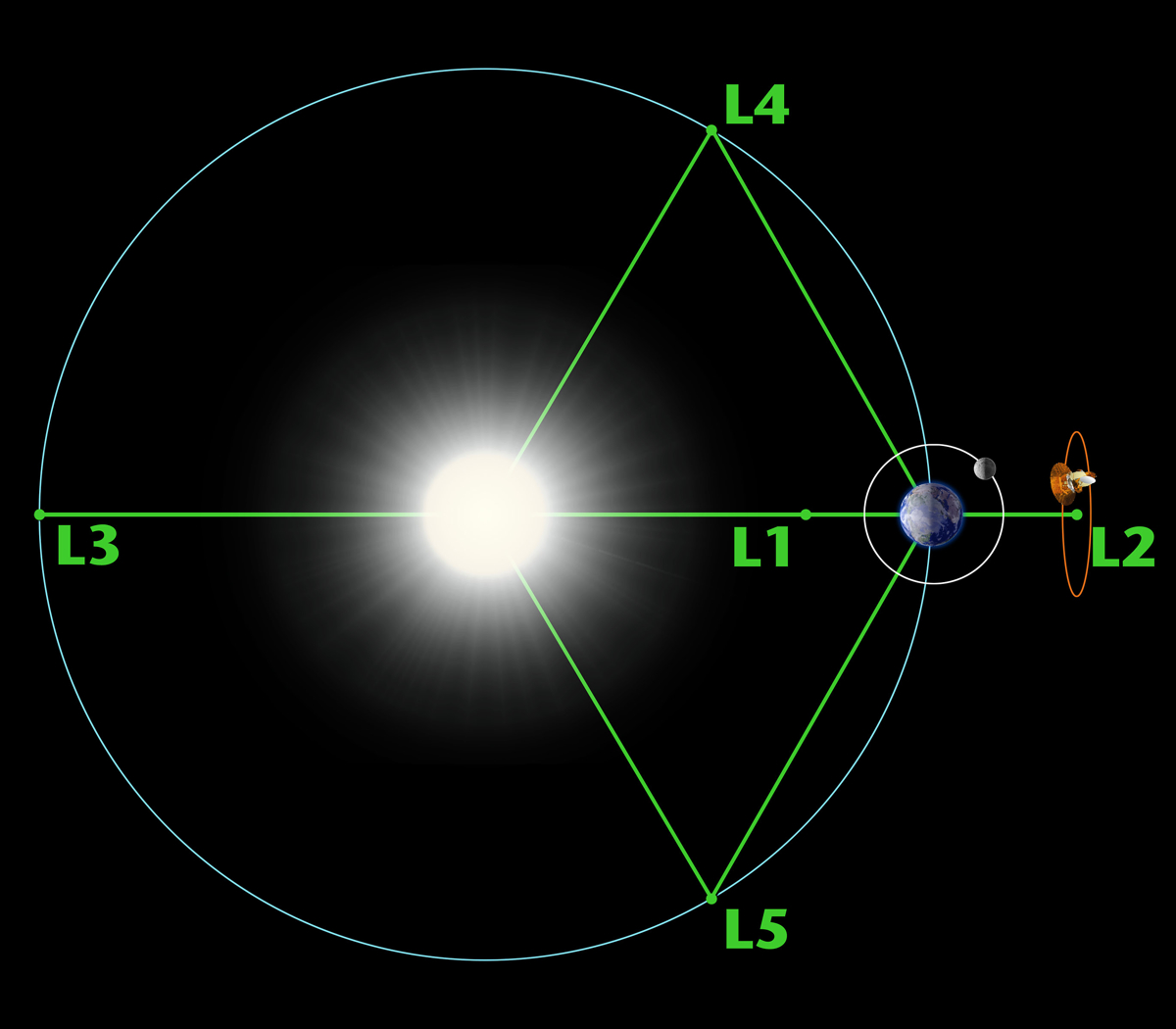What are Lagrange points?
Lagrange points are gravitationally balanced locations where spacecraft can perform their missions.

Lagrange points, or Lagrangian points, are locations in space where objects can stay in position relative to another, larger body.
They are made possible by the balance of gravitational and centripetal forces — for example, between Earth and the sun, or between Earth and the moon, NASA explains.
Because Lagrange points are easy to reach, many spacecraft are sent to perform their observations from these locations.
Related: How Lagrange points solved one of physics' biggest problems
Lagrange point FAQs
What is a Lagrange point in simple terms?
A Lagrange point is a region of space where gravitational and centripetal forces balance so that an object, such as a spacecraft or an asteroid, can remain stationary relative to a larger body, such as Earth. The Lagrange points are particularly useful for parking space probes.
Does Earth have a Lagrange point?
Earth has five Lagrange points, as does Earth's moon. Earth's L1 and L2 points are within the easiest reach of space missions.
How far is the L1 point from Earth?
The Earth-sun L1 point is about 932,000 miles (1.5 million km) from Earth. The L2 point is the same distance but in the opposite direction, away from the sun. It took the James Webb Space Telescope about a month to reach L2.
How many Lagrange points are there?

Each pair of gravitational bodies has five Lagrange points. Let's take Earth and the sun as an example. The first Lagrange point, L1, is between Earth and the sun. The second Lagrange point, L2, is on the opposite side of Earth from the sun. Because the sun is partially blocked by Earth, L2 provides a dark, unhindered vantage point for space telescopes such as the James Webb Space Telescope (JWST) to view the universe, according to NASA.
L3 is located on the opposite side of the sun to Earth, so we cannot see it. L4 and L5 are positioned 60 degrees in front of and 60 degrees behind Earth in its orbit and are where the Trojan asteroids cluster.
These five points are mirrored in other pairs of bodies. For example, the Earth-moon system has its own set of Lagrange points. L1 is between Earth and the moon, L2 is on the far side of the moon, L3 is on the opposite side of Earth to the moon, and L4 and L5 are 60 degrees in front of and behind the moon on its orbit around Earth.
Who discovered the Lagrange points?
The history of the Lagrange points goes back to the mid-to-late 18th century, long before there were rockets or spacecraft. Much of the legwork had been done in the previous century, with Johannes Kepler's three laws of planetary motion and Isaac Newton's laws of gravitation, which together describe how the moon orbits Earth, and how Earth and the other planets orbit the sun.
The first three Lagrange points were initially proposed by the great mathematician Leonhard Euler in 1760 while he was studying the inward and outward forces acting on a large body orbiting another object, such as the sun. Later, in the early 1770s, Joseph-Louis Lagrange, who was Euler's student, discovered L4 and L5 and corroborated Euler's earlier work.
How do Lagrange points work?
A spacecraft at a Lagrange point feels a balance between the gravitational pull of two large bodies — such as Earth and the sun, or Earth and the moon — on a smaller object, and the centripetal force needed for that smaller object to move in time with them and thus appear to remain in a specific location relative to them, NASA explains. Such a location is a Lagrange point.
For example, at the L1 point, which lies between Earth and the sun, the sun's gravity will pull a spacecraft around it faster than Earth orbits the sun. (Kepler's second law of planetary motion tells us that the closer an object is to the sun, the faster it will orbit.) However, Earth's gravity can pull back on a spacecraft, slowing it down. At L1, all of these forces are in balance, and a spacecraft at L1 would be moving slow enough to maintain its position, at least temporarily.
The situation is reversed for L2, which is a little farther from the sun than Earth is. Here, spacecraft should orbit the sun a little more slowly than our planet does, but Earth's gravity can pull them along and balance the forces.
The European Space Agency (ESA) describes L1, L2 and L3 as "meta-stable," meaning that, over longer periods of time, spacecraft or asteroids will drift out of them. L4 and L5 are permanently stable over billions of years, which is why the Trojan asteroids can remain there.
What are the distances to the Lagrange points?
The distance to the Earth-sun Lagrange point 1 is about 932,000 miles (1.5 million kilometers) from Earth. Lagrange Point 2 is the same distance in the opposite direction. Lagrange Point 3 is about 186 million miles (300 million km) from us. Both L4 and L5 are about 19 million miles (30 million km) from Earth.
Given the relatively short distances to the Earth-sun L1 and L2 points, they can be easily accessed by spacecraft. Because the Earth-moon Lagrange points are much closer to us, all of them can be reached.
What spacecraft are currently at the Lagrange points?
Several spacecraft are found at the Earth-sun L1 point. These include the joint ESA-NASA Solar and Heliospheric Observatory and NASA's Advanced Composition Explorer and Wind missions, which study the solar wind. In September 2023, the Indian Space Research Organisation launched Aditya-L1, a solar mission to L1. Meanwhile, the National Oceanic and Atmospheric Administration's Deep Space Climate Observatory is at L1, looking back at Earth.
The Earth-sun L2 point has become famous recently as the home of JWST. It is joined at L2 by ESA's Euclid and Gaia missions and a German-Russian high-energy astrophysics mission called Spektr-RG. Past missions at L2 include NASA's Wilkinson Microwave Anisotropy Probe and ESA's Planck mission, both of which studied the cosmic microwave background, and ESA's Herschel Space Observatory.
Future missions to L2 will include NASA's Nancy Grace Roman Space Telescope, ESA's PLATO and ARIEL exoplanet missions, and the joint ESA-Japan Aerospace Exploration Agency Comet Interceptor spacecraft.
There are no current missions at L3, L4 or L5.
What are Trojan asteroids?
Because L4 and L5 are permanently stable Lagrange points, any objects that exist in them will remain there. As such, asteroids can become trapped at L4 and L5. Astronomers call these objects Trojan asteroids.
Jupiter has the most Trojan asteroids. More than 10,000 have been detected so far, with more at L5 than at L4. NASA's Lucy mission launched in October 2021 to explore Jupiter's Trojan asteroids and will arrive at its first one in 2027.
Trojans have also been found, in much smaller numbers, at the L4 and L5 points of Venus, Earth, Mars, Uranus and Neptune, which, after Jupiter, has the most, with 31 known Trojans as of the end of 2023.
Additional resources
You can read more about the five Lagrange points in this article by Neil deGrasse Tyson. If you're more mathematically inclined, check out this NASA PDF describing the Lagrange points using equations. For an animated view and description of Lagrange points, watch this NASA video featuring Hal Levison, principal investigator for the Lucy mission.
Bibliography
Neil J. Cornish, 'What Are Lagrange Points?', NASA, 2023
https://science.nasa.gov/solar-system/resources/faq/what-are-lagrange-points/
'Webb Orbit', Goddard Space Flight Center, https://webb.nasa.gov/content/about/orbit.html#:~:text=The%20James%20Webb%20Space%20Telescope,second%20Lagrange%20point%20or%20L2
Steigerwald, William; 'How Were the Trojan Asteroids Discovered and Named?' NASA, 2021, https://www.nasa.gov/missions/how-were-the-trojan-asteroids-discovered-and-named/
Maccone, Claudio; 'The Lunar Farside Radio Lab Study of the IAA', https://www.researchgate.net/publication/228781180_The_Lunar_Farside_Radio_Lab_Study_of_the_IAA
Wright, Alison; 'The Trojan is Out There', Nature Physics, 7, 592, 2011, https://www.nature.com/articles/nphys2061
'Joseph Louis Lagrange', Physics Today, 2017, https://pubs.aip.org/physicstoday/Online/9280/Joseph-Louis-Lagrange
'What Are Lagrange Points?' European Space Agency, https://www.esa.int/Enabling_Support/Operations/What_are_Lagrange_points
'L2, the Second Lagrangian Point', European Space Agency, https://www.esa.int/Science_Exploration/Space_Science/Herschel/L2_the_second_Lagrangian_Point
Karen Sottosanti, 'Lagrange Point', Encyclopaedia Britannica, 2023, https://www.britannica.com/science/Lagrangian-point
'An Assessment of Space Situation Around Sun–Earth Lagrange Point L1', Indian Space Research Organisation, 2023, https://www.isro.gov.in/Assessment_spacesituation_LagrangePoint_L1.html
'SOHO Overview', European Space Agency, https://www.esa.int/Science_Exploration/Space_Science/SOHO_overview2
'ACE: Advanced Composition Explorer', NASA, https://science.nasa.gov/mission/ace/
'Aditya-L1', Indian Space Research Organisation, https://www.isro.gov.in/Aditya_L1.html
'Deep Space Climate Observatory', Harvard–Smithsonian CfA, https://pweb.cfa.harvard.edu/facilities-technology/telescopes-instruments/deep-space-climate-observatory-dscovr
'Euclid's Journey to L2', European Space Agency, https://www.esa.int/ESA_Multimedia/Images/2023/05/Euclid_s_journey_to_L2
'Gaia Mission', Gaia in the UK, https://www.gaia.ac.uk/mission
'Illustration of the Spektr-RG spacecraft', European Space Agency, 2020, https://www.esa.int/ESA_Multimedia/Images/2020/06/Illustration_of_the_Spektr-RG_spacecraft
'WMAP Trajectory and Orbit', NASA, https://wmap.gsfc.nasa.gov/mission/observatory_orbit.html
'Planck Satellite Manoeuvre Aims at L2 Arrival', European Space Agency, 2009, https://www.esa.int/Enabling_Support/Operations/Planck_satellite_manoeuvre_aims_at_L2_arrival
'Herschel', European Space Agency, https://www.esa.int/Enabling_Support/Operations/Herschel
'Observatory', Nancy Grace Roman Telescope, NASA Goddard Space Flight Center, https://roman.gsfc.nasa.gov/observatory.html
'PLATO factsheet', European Space Agency, https://www.esa.int/Science_Exploration/Space_Science/Plato_factsheet
'ARIEL Factsheet', European Space Agency, https://www.esa.int/Science_Exploration/Space_Science/Ariel_factsheet
'Mission', Comet Interceptor, https://www.cometinterceptor.space/mission.html#:~:text=Comet%20Interceptor%20is%20planned%20to,point%20observations%20around%20the%20target.
Talbert, Tricia; What are the Trojan Asteroids? We Asked a NASA Scientist, Episode 8, NASA, 2021, https://www.nasa.gov/solar-system/what-are-the-trojan-asteroids-we-asked-a-nasa-scientist-episode-8/#:~:text=So%2C%20what%20are%20the%20Trojan,formation%20of%20our%20solar%20system
Bottke, William F. et al; 'Origin and Evolution of Jupiter's Trojan Asteroids', Space Science Reviews, 219, 83, 2023, https://link.springer.com/article/10.1007/s11214-023-01031-4
Li, Jian et al; 'Asymmetry in the number of L4 and L5 Jupiter Trojans driven by jumping Jupiter', Astronomy & Astrophysics, 669, A68, 2023 https://www.aanda.org/articles/aa/full_html/2023/01/aa44443-22/aa44443-22.html
LUCY: Twelve Years, Eleven Asteroids, One Spacecraft, https://lucy.swri.edu/
'Astronomers Find Second Known Earth Trojan Asteroid', National Science Foundation, 2022, https://new.nsf.gov/news/astronomers-find-second-known-earth-trojan
List of Neptune Trojans, Minor Planet Center, 2023, https://minorplanetcenter.net//iau/lists/NeptuneTrojans.html
Join our Space Forums to keep talking space on the latest missions, night sky and more! And if you have a news tip, correction or comment, let us know at: community@space.com.
Get the Space.com Newsletter
Breaking space news, the latest updates on rocket launches, skywatching events and more!

Keith Cooper is a freelance science journalist and editor in the United Kingdom, and has a degree in physics and astrophysics from the University of Manchester. He's the author of "The Contact Paradox: Challenging Our Assumptions in the Search for Extraterrestrial Intelligence" (Bloomsbury Sigma, 2020) and has written articles on astronomy, space, physics and astrobiology for a multitude of magazines and websites.










